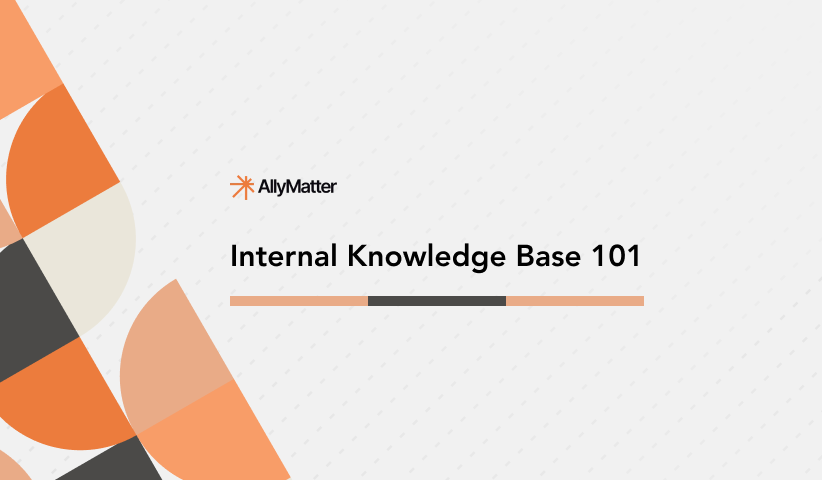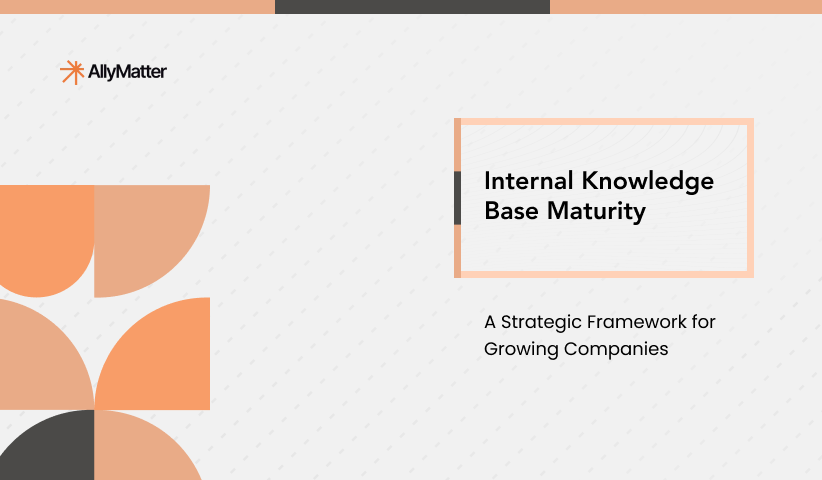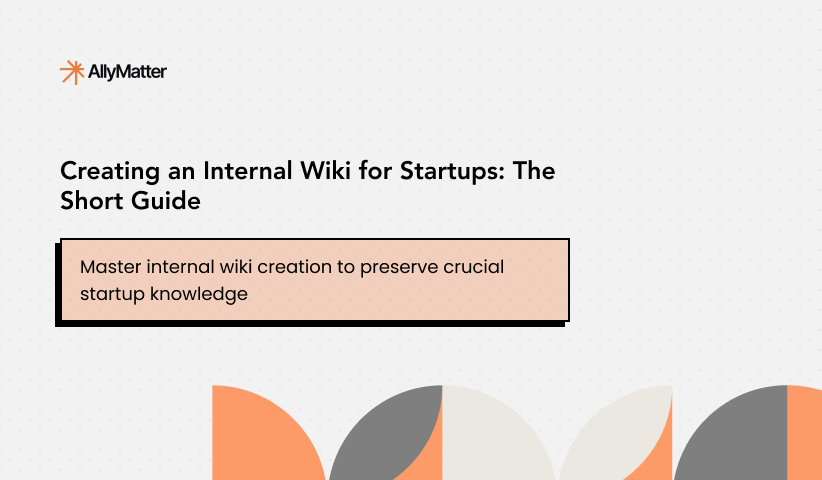Creating a well-structured internal knowledge base isn’t just about dumping information into a digital folder – it’s about building an organized, accessible hub that becomes your company’s single source of truth. As someone who’s helped dozens of businesses transform their scattered documentation into streamlined knowledge management systems, I’ve seen firsthand how proper structuring can make or break an internal knowledge base’s success. Whether you’re a growing startup drowning in Google Docs or an established SMB looking to centralize tribal knowledge, the way you structure your internal knowledge base will determine if employees actually use it or abandon it for the familiar “hey, can you send me that document again?” routine.
Before we dive into knowing how to structure internal knowledge base, let’s get aligned on why it matters.
In this comprehensive guide, you’ll learn how to build a clear, scalable internal knowledge base — from setting up intuitive hierarchies to leveraging AI for smarter content organization. We’ll take your company’s knowledge management from cluttered and inconsistent to streamlined, searchable, and sustainable.
Establish a clear hierarchy
When establishing your internal knowledge base’s hierarchy, think of it like designing your company’s office layout – every piece of information needs a logical “home” where employees can find it without asking for directions. A well-planned hierarchy isn’t just about organization; it’s about creating intuitive pathways to knowledge that mirror how your team actually works and thinks.
The answer to the question of how to structure internal knowledge base lies in a logical hierarchy that makes sense for your specific organization. This isn’t a one-size-fits-all solution – your hierarchy should reflect your company’s unique workflows and organizational structure.
Mirror your organization’s structure
Start by mapping out your hierarchy to match your company’s natural organization. For example:
- Department level: Create top-level categories for major departments (HR, Sales, Marketing, IT)
- Team level: Within each department, break down into team-specific sections
- Function level: Further subdivide based on specific functions or processes
- Document level: Individual documents and articles at the most granular level
Create logical parent-child relationships
Think of your hierarchy like a family tree. Each piece of content should have clear relationships to other content:
- Main categories (parents) should encompass related subcategories (children)
- Related topics should be grouped together under common parent categories
- Depth shouldn’t exceed 3-4 levels to prevent navigation complexity
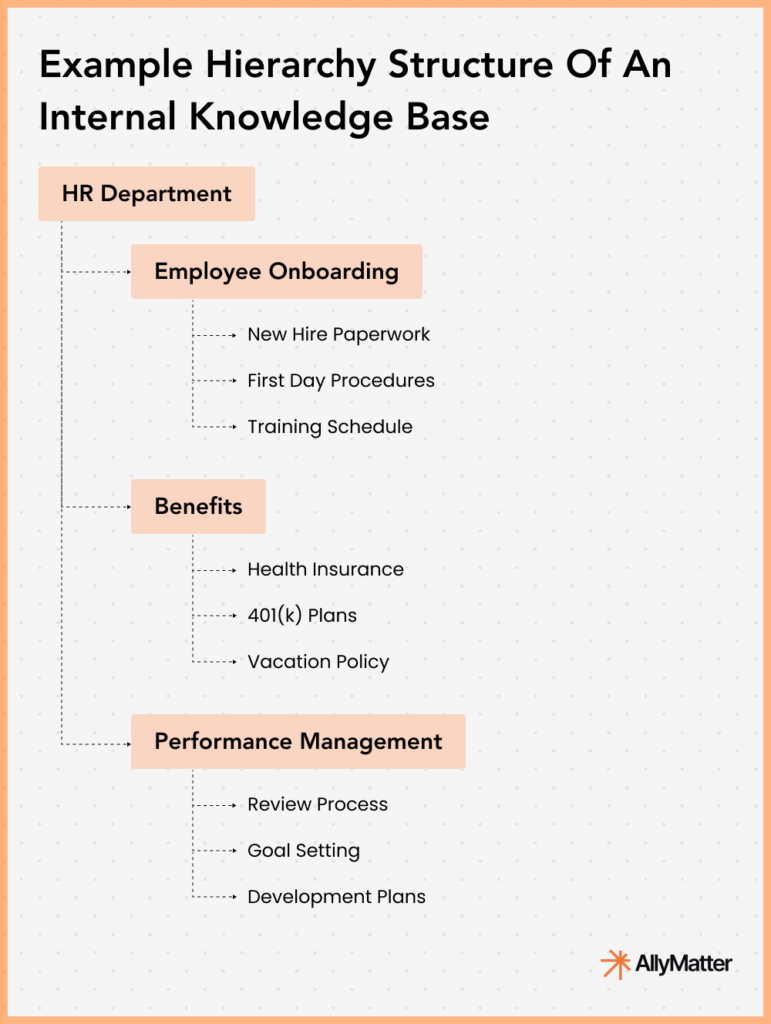
Best practices for hierarchy design:
- Keep your structure shallow but broad – aim for more categories at each level rather than deep nesting
- Use clear, consistent naming conventions for all levels of your hierarchy
- Ensure each item has only one logical location to prevent confusion
- Leave room for growth – your hierarchy should be able to expand as your organization grows
Remember, the goal isn’t to create the perfect hierarchy on day one. Start with a basic structure that makes sense for your current needs, and be prepared to refine it based on how your team actually uses the knowledge base. Monitor which sections get the most traffic and where people seem to get lost, then adjust accordingly.
Define and standardize content
Just as every successful restaurant has a recipe book that ensures consistency across every dish, your internal knowledge base needs clear standards for its content. Without standardization, your knowledge base can quickly become a confusing mix of different writing styles, formats, and structures – making it harder for employees to find and understand information quickly.
Create clear definitions
Think of definitions as your organization’s common language. When an employee reads about a “priority lead” in sales documentation or a “critical incident” in IT procedures, everyone should understand exactly what these terms mean.
Here’s how to implement clear definitions:
- Create a centralized glossary section in your knowledge base
- Define company-specific terminology and acronyms
- Use plain language explanations where possible
- Include examples with each definition
- Link terms to their definitions throughout your documentation
Standardize titles and formatting
Your content’s format should be as predictable as a well-designed form. Users should know exactly where to look for specific information in any document.
Title formats
Use consistent patterns for different types of content:
- How-to Guides: “How to [Complete Task]” (e.g., “How to Process a Refund”)
- Policies: “[Department] [Policy Type] Policy” (e.g., “HR Leave Policy”)
- Procedures: “[Task Name] Procedure” (e.g., “Customer Onboarding Procedure”)
- Reference Guides: “[Topic] Reference Guide” (e.g., “Product Feature Reference Guide”)
Document templates
Create templates for common document types:
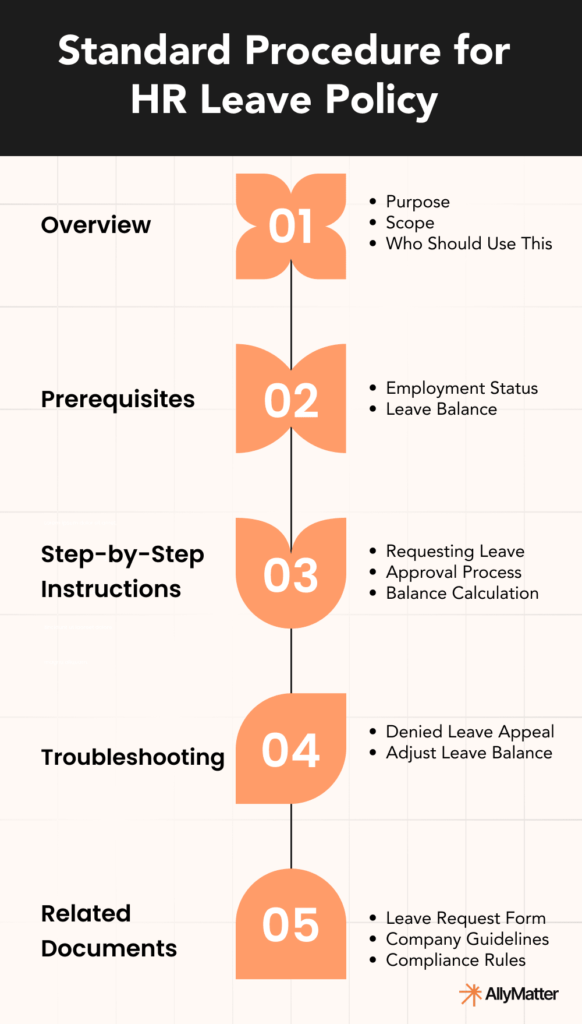
Maintain consistency
Consistency isn’t just about looking professional – it’s about reducing cognitive load for your employees. When content follows familiar patterns, users can focus on the information rather than figuring out how to navigate the document.
Key areas for consistency:
- Visual formatting
- Use consistent heading levels (H1 for titles, H2 for main sections, etc.)
- Maintain standard font sizes and types
- Apply consistent spacing and alignment
- Use uniform bullet and numbering styles
- Writing style
- Maintain a consistent voice (formal vs. conversational)
- Use the same tense throughout procedures
- Keep standard paragraph lengths
- Follow the same capitalization rules
- Content structure
- Begin each document with a clear purpose statement
- Include standard sections in a consistent order
- Use consistent metadata fields
- End with related resources or next steps
Remember, your goal is to make the format of your content so consistent that it becomes invisible, allowing users to focus entirely on finding and understanding the information they need.
Organize with tags and categorization
Think of tags and categories as the GPS system for your internal knowledge base – they help users navigate to their destination through multiple routes. While your hierarchy provides the main roads, a robust tagging system creates helpful shortcuts and alternate paths to information.
While a clear hierarchy creates the main structure of your internal knowledge base, a robust system of tags and categories creates additional pathways to help employees find information quickly and intuitively.
Think of it as the difference between finding a book by walking through library shelves (hierarchy) versus using the library’s catalog system (tags and categories) – both methods serve different search styles and needs. A well-designed tagging and categorization system acts as your knowledge base’s safety net, ensuring that even if users don’t know exactly where a piece of information lives in the hierarchy, they can still find it through multiple logical paths.
Here’s how to create an organization system that accommodates different ways of thinking and searching:
Implement an effective tagging system
Just as a library uses multiple classification systems to help readers find books, your knowledge base needs a well-thought-out tagging structure. Here’s how to build one:
Core Tagging Framework
- Primary tags: Broad categories that align with key business functions
- Department tags (HR, Sales, IT, Finance)
- Process tags (Onboarding, Reporting, Compliance)
- Content type tags (Policy, Procedure, Guide, Template)
- Secondary tags: More specific identifiers
- Project names
- Product lines
- Geographic regions
- Skill levels (Beginner, Advanced)
Tagging best practices
- Limit tag proliferation by creating a controlled vocabulary
- Use auto-suggest for existing tags during content creation
- Implement tag hierarchies (parent-child relationships)
- Regular audit and cleanup of unused or redundant tags
Example tag structure
- Example Tag Structure:
- Primary: Department:HR
- Secondary: Process:Onboarding
- Tertiary: ContentType:Procedure
Navigation and Breadcrumbs
Think of breadcrumbs as leaving a trail of digital breadcrumbs that shows users exactly how they got to their current location and how to get back.
Essential navigation elements
- Clear breadcrumb trails
Home > HR > Onboarding > New Hire Procedures
Show the full path to current content
- Make each level clickable
- Keep paths shallow (3-4 levels maximum)
- Cross-references
- Link related documents within content
- Show “Related Articles” sections
- Implement “See Also” suggestions
- Create content clusters around common themes
- Smart navigation features
- Recently viewed items
- Most accessed content
- Favorite/bookmark capability
- Custom navigation shortcuts for different user roles
Metadata management
Metadata is your knowledge base’s behind-the-scenes organizer. Like a well-organized filing system, good metadata makes information easier to find, manage, and maintain.
Essential metadata fields
- Document Metadata Example:
- Title: New Employee Onboarding Checklist
- Owner: HR Department
- Last Updated: [Date]
- Version: 2.1
- Applicable Roles: HR Managers, Team Leaders
- Review Date: [Next Review Date]
- Status: Active
Implementation tips
- Create mandatory metadata fields for all content
- Use dropdown menus for consistent metadata entry
- Implement automated metadata capture where possible
- Regular metadata audits for accuracy and completeness
Prioritize and maintain content
Just as a busy emergency room needs clear protocols for prioritizing patients, your internal knowledge base needs a systematic approach to prioritizing and maintaining its content.
Without proper prioritization, critical information can get buried under less important content, and without regular maintenance, even the best-organized knowledge base can quickly become a graveyard of outdated information. Think of it as maintaining a living library where some books need daily updates, others need quarterly revisions, and some require annual reviews to stay relevant.
By establishing clear priorities and maintenance schedules, you ensure that employees can always trust the accuracy and relevance of your knowledge base content.
Unlike static document repositories, an effective internal knowledge base is a dynamic system that requires ongoing attention and care. Let’s look at how to establish a sustainable system for prioritizing and maintaining your content:
Content prioritization
Not all content carries equal weight in your knowledge base. Like a hospital’s triage system, you need to identify what’s critical, what’s important, and what’s nice to have.
Priority levels
Level 1 (critical)
- – Core operational procedures
- – Legal and compliance documents
- – Emergency protocols
- – Key security policies
Level 2 (high priority)
- – Standard operating procedures
- – Training materials
- – Product documentation
- – Customer service protocols
Level 3 (standard)
- – General information
- – Background resources
- – Supplementary guides
- – Historical documentation
Implementation strategies
- Use visual indicators for priority levels (icons, colors, tags)
- Place high-priority content in prominent locations
- Create shortcuts to critical information
- Enable priority-based search filters
Maintenance procedures
Regular maintenance isn’t just about updating content – it’s about ensuring your knowledge base remains a reliable, trustworthy resource.
Content review cycle
Like any critical business system, your internal knowledge base needs a structured maintenance schedule to stay reliable and useful. Just as you wouldn’t skip maintenance on your company’s servers or security systems, your knowledge base requires regular attention through systematic reviews, careful version control, and thorough content auditing. Here’s how to implement a robust maintenance routine:
Regular reviews
A tiered review schedule ensures that your most critical content stays current while managing the workload of content maintenance effectively.
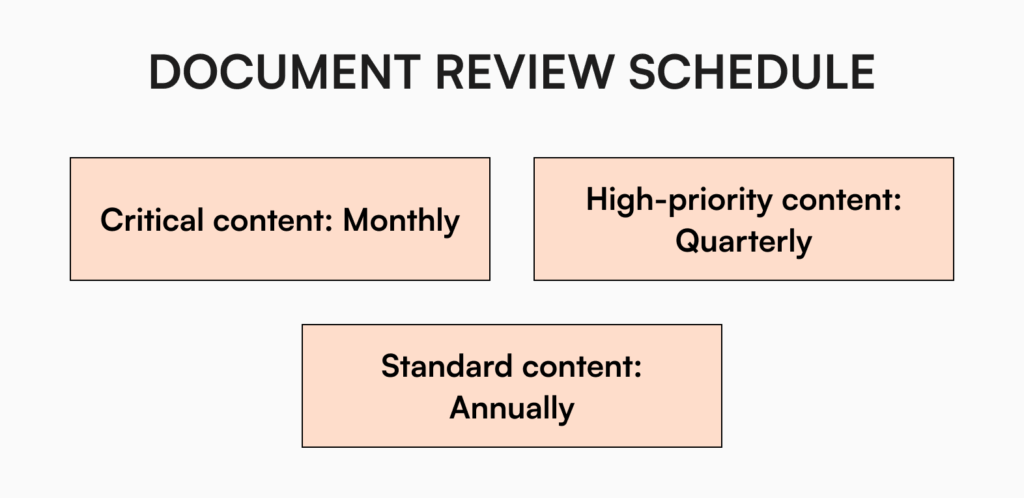
Content review cycle for an employee handbook
Critical content (monthly review)
- IT Security Policy
- Crisis Management Plan
High-priority content (quarterly review)
- Employee Benefits Overview
- Performance Evaluation Guidelines
Standard content (annual review)
- Company Mission & Values
- Dress Code Policy
Version control
Think of version control as your content’s safety net, tracking every change and maintaining a clear history of what changed, why, and when.
- Track all content changes
- Maintain version history
- Document update reasons
- Archive outdated versions
Content auditing
Regular audits act as your knowledge base’s health check, ensuring that all information remains accurate, accessible, and relevant.
- Check for accuracy
- Verify links and references
- Update screenshots and examples
- Remove redundant information
Maintenance roles and responsibilities
Maintaining a knowledge base isn’t a one-person job—it requires a coordinated effort from multiple roles, each with specific responsibilities in keeping content accurate, up-to-date, and valuable. Like a well-oiled machine, each role plays a crucial part in the knowledge management process.
Content owner
Think of the Content Owner as the “product manager” for specific sections of your knowledge base. This person:
- Takes ultimate responsibility for the accuracy and timeliness of content
- Makes strategic decisions about content updates and retirement
- Approves major changes and revisions
- Ensures content aligns with compliance requirements and company standards
Content editor
The content editor acts as the daily caretaker of your knowledge base, handling:
- Regular content updates and refinements
- Style and formatting consistency
- Implementation of feedback and changes
- Version management and documentation
Subject matter expert (SME)
SMEs serve as your technical advisors, providing:
- Expert review of technical content accuracy
- Specialized knowledge input for complex topics
- Validation of procedures and processes
- Updates on industry standards and best practices
By clearly defining these roles and their responsibilities, you create accountability and ensure that your knowledge base maintains its quality and relevance over time.
Quality control process
Just as manufacturers have quality control checkpoints, your knowledge base needs systematic quality checks to maintain standards.
Quality checkpoints
- Content creation
- Template compliance
- Style guide adherence
- Required metadata
- Proper categorization
- Regular review
- Accuracy verification
- Link checking
- Format consistency
- Metadata updates
- User feedback
- Feedback collection system
- User ratings
- Usage analytics
- Improvement suggestions
Documentation health metrics
Monthly health check:
- Outdated content percentage
- Broken links count
- User satisfaction scores
- Search success rates
- Page view statistics
- Feedback responses
AI and smart structuring
AI is a powerful ally in keeping your internal knowledge base organized, relevant, and user-friendly. Think of AI as having a tireless digital librarian who works 24/7 to analyze how your employees search for and use information, identify patterns in their behavior, and automatically optimize content organization based on these insights. While traditional knowledge base structures rely on manual organization and updates, AI-powered systems can adapt and improve automatically based on real usage patterns. By using AI and smart structuring technologies, you can create a knowledge base that becomes more intelligent and useful over time, reducing the manual maintenance burden while improving the user experience.
AI-powered organization
Like a librarian who learns which books different readers prefer, AI can personalize and improve your knowledge base’s organization over time.
AI implementation areas
Content analysis
- Search pattern recognition
- Usage behavior tracking
- Content gap identification
- Topic clustering
Smart suggestions
- Related content recommendations
- Personalized content paths
- “People also viewed” suggestions
- Smart FAQs generation
Automated improvements
- Auto-tagging based on content analysis
- Smart categorization suggestions
- Content relationship mapping
- Automatic summary generation
Optimize search and technology integration
Your knowledge base’s search function should work like a skilled concierge – understanding what users want even when they’re not sure how to ask for it.
Search optimization
A powerful search function is the backbone of any effective internal knowledge base – after all, even perfectly organized content is useless if employees can’t find it when they need it. Think of search optimization as building a smart assistant who understands not just what users are asking for, but what they actually need. While your knowledge base’s hierarchical structure provides one way to find information, an optimized search function creates multiple pathways to the same destination, accommodating different search styles and user needs. Here’s how to build a search system that helps employees find exactly what they’re looking for, even when they’re not sure what that is.
Advanced search features
Core search components:
Natural language processing
– Understand conversational queries
– Handle synonyms and variations
– Recognize industry terminology
Smart filters
– Department-specific searching
– Date range filtering
– Content type filtering
– Author/owner filtering
Results enhancement
– Relevance ranking
– Search result previews
– Quick action buttons
– Save search functionality
System integration
Like connecting different rooms in a house, your knowledge base should seamlessly connect with other business tools.
Integration points
Common integrations:
– HR systems
– Project management tools
– Communication platforms
– CRM systems
– Support ticket systems
Implementation steps
Single sign-on (SSO)
- Unified authentication
- Role-based access control
- Security compliance
- User provisioning
Data synchronization
- Automated updates
- Real-time syncing
- Conflict resolution
- Backup procedures
Monitor performance and continuously improve
Just as you monitor key business metrics to gauge your company’s health, your internal knowledge base needs consistent performance tracking and optimization to ensure it continues serving your organization effectively. Think of it as a living system that requires regular check-ups and adjustments – what worked six months ago might need fine-tuning today as your organization grows and evolves. Without proper monitoring, you might miss crucial signs that your knowledge base isn’t meeting employee needs or keeping pace with your company’s changes. By implementing a robust monitoring and improvement system, you can catch issues early, identify opportunities for enhancement, and ensure your knowledge base remains a valuable asset rather than becoming digital clutter. Here’s how to set up a comprehensive system for tracking performance and driving continuous improvement:
Performance tracking
Key metrics to monitor
Usage metrics
– Page views and unique visitors
– Search success rates
– Time spent on pages
– Navigation paths
Content metrics
– Most/least accessed content
– Failed searches
– Feedback ratings
– Update frequency
Analytics implementation
- Set up tracking dashboards
- Configure custom reports
- Implement user journey mapping
- Track engagement patterns
Continuous improvement process
Improving your knowledge base isn’t a one-time project but rather an ongoing cycle of gathering feedback, analyzing patterns, making changes, and measuring results. Like a well-designed agile process, your improvement system should be iterative and responsive to real user needs and behaviors, constantly evolving to better serve your organization.
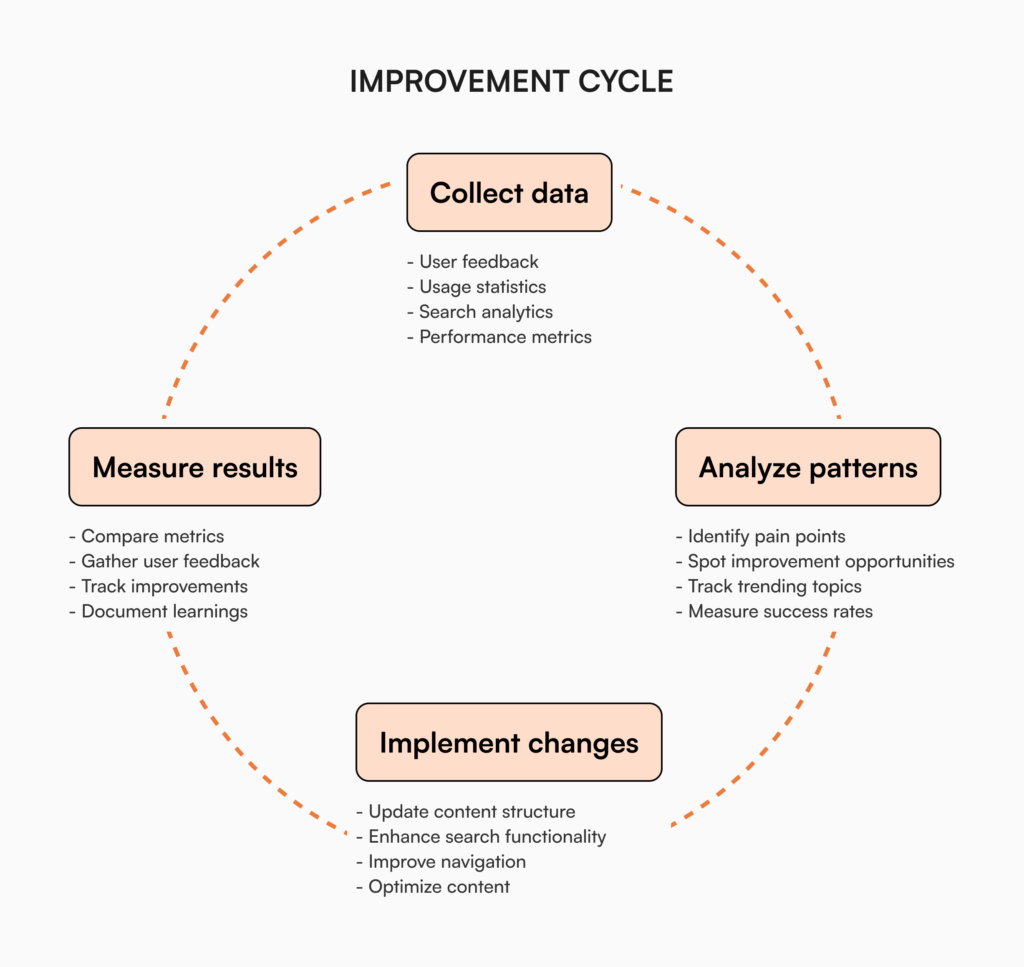
Improvement cycle
Collect data
– User feedback
– Usage statistics
– Search analytics
– Performance metrics
Analyze patterns
– Identify pain points
– Spot improvement opportunities
– Track trending topics
– Measure success rates
Implement changes
– Update content structure
– Enhance search functionality
– Improve navigation
– Optimize content
Measure results
– Compare metrics
– Gather user feedback
– Track improvements
– Document learnings
Conclusion
A well-structured internal knowledge base is never truly “finished” – it’s an evolving ecosystem that grows and adapts with your organization. Start with these foundational elements, but remember to:
- Regularly assess and adjust your structure
- Listen to user feedback and adapt accordingly
- Keep content fresh and relevant
- Leverage technology to enhance accessibility
- Measure and improve continuously
By following these guidelines and maintaining a consistent focus on usability and relevance, you’ll create an internal knowledge base that becomes an invaluable asset for your organization. Remember, the goal isn’t perfection from day one, but rather creating a sustainable system that can evolve with your company’s needs.
Ready to Structure Your Internal Knowledge Base the Right Way? Book your personalized consultation today.
